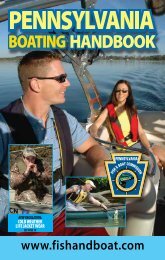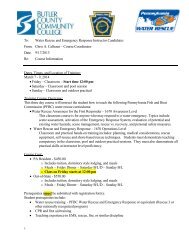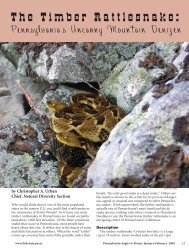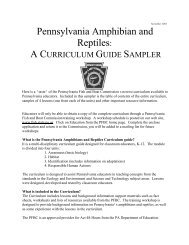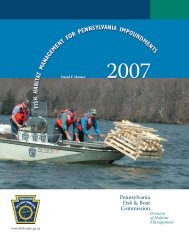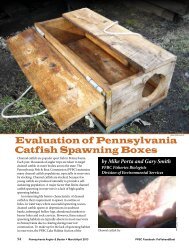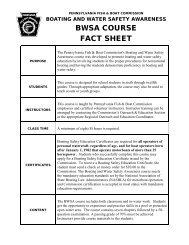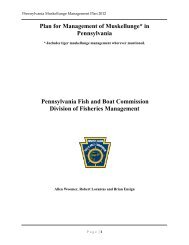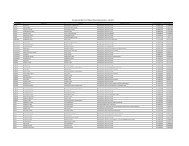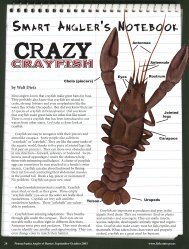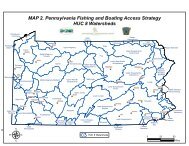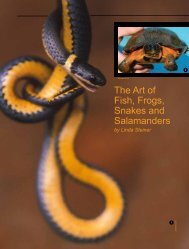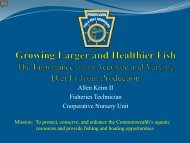^Tn^Z^Ei*] - Pennsylvania Fish and Boat Commission
^Tn^Z^Ei*] - Pennsylvania Fish and Boat Commission
^Tn^Z^Ei*] - Pennsylvania Fish and Boat Commission
Create successful ePaper yourself
Turn your PDF publications into a flip-book with our unique Google optimized e-Paper software.
FOR the red-green-orange spell he<br />
can weave over the smartest trout.<br />
For the exalted position he holds in<br />
the fly box of almost every angler.<br />
For the long-time popularity he has<br />
enjoyed, <strong>and</strong> for his survival of a lot<br />
of the modernizing fad that has radically<br />
changed some of his brothers—<br />
For all these things, we nominate<br />
a king for the domain of trout flies.<br />
He is the Royal Coachman.<br />
There are other trout flies which<br />
are universal favorites <strong>and</strong> which also<br />
are efficient fish-takers.<br />
But the Royal Coachman has the<br />
dash <strong>and</strong> color of a monarch.<br />
He looks like no living thing.<br />
At least this writer never heard of<br />
an insect, fish, animal, bird or reptile<br />
that has a red body with green edges,<br />
an orange tail with black bars, with<br />
a speck of gold as a finishing touch at<br />
the rear of the body, not to mention<br />
brown—<strong>and</strong> sometimes white—legs.<br />
The Royal Coachman has all those<br />
features, whether he be made up as<br />
a floating dry fly, a bedraggled wet fly,<br />
or a miniature streamer.<br />
So much for his appearance.<br />
As for his popularity, it seems logical<br />
to explain this feature of His Royal<br />
Highness by the fact that he ranks as<br />
a top-flight attractor—that is, a fly that<br />
will interest trout when they are ignoring<br />
other more conventional patterns<br />
of flies.<br />
His Royal Highness<br />
By Dick Fortney<br />
Another factor that certainly cannot<br />
be overlooked is the fact that the<br />
Royal Coachman is easily seen when<br />
floating on the water—<strong>and</strong> that is important<br />
for those of the angling fraternity<br />
who have to struggle under the<br />
h<strong>and</strong>icap of bifocal glasses.<br />
Be the reasons what they may, it's<br />
a safe bet that the vast majority of<br />
trout fishermen in <strong>Pennsylvania</strong> regard<br />
the Royal Coachman as a st<strong>and</strong>by.<br />
Legions of anglers would not think<br />
of going astream for a day without a<br />
supply of the flies of this pattern in<br />
their fly boxes.<br />
Of course, there are some dissenters.<br />
We know one chap who has a peeve<br />
against the Royal Coachman. He'd<br />
rather get skunked than use it. He<br />
prides himself on his insistence on<br />
using flies that really represent natural<br />
insects.<br />
"Why, that danged blob of color<br />
doesn't look like any insect," he once<br />
told me in scorn. "I have more respect<br />
for trout than to use that fly. If I can't<br />
catch fish on regular flies, I'll go without<br />
'em."<br />
I like the guy, so I didn't point out<br />
the fact that I was having a lot of<br />
fun <strong>and</strong> he wasn't interesting many<br />
trout, although he is as good a trout<br />
angler as can be found in Central<br />
<strong>Pennsylvania</strong>.<br />
There is a type of Royal Coachman<br />
to suit every angling problem. First,<br />
Trout in a mountain stream never saw a natural Insect that looks like the Royal C<br />
but they'll strike a fly of that pattern.<br />
there is the conventional dry patte^<br />
Then there is the bivisible. Third *<br />
the conventional wet fly. Fourth is ,<br />
variation of the wet fly best describ e<br />
as a miniature streamer. All four p 3<br />
terns have the same specification<br />
however.<br />
The body is a brilliant red, with i<br />
collar of green peacock herl back 8J$<br />
front. The hackle is brown. The ttt<br />
is made of whisps of a golden pheasaP<br />
tippet or whisps of brown hacK*'<br />
The wings are white. The tag is<br />
twist of gold wire at the bend of *|j<br />
hook, just aft of the wrapping of h?<br />
that forms the back end of the boj?e<br />
terial mats when wet, <strong>and</strong> only i<br />
bushy, luxuriant herl should be u s .<br />
The gold tag presumably is inten 0 ,^<br />
to attract the attention of the fish ^ $<br />
its tiny but piercing glitter. Many C ,,<br />
regard the tag as not essential, h° .<br />
ever, <strong>and</strong> certainly no one will are g<br />
that omitting it will make the fly *<br />
effective. .,<br />
The wings of the dry Royal C°? C 0f<br />
man may be made of either quill<br />
PENNSYLVANIA ANGl t*


![^Tn^Z^Ei*] - Pennsylvania Fish and Boat Commission](https://img.yumpu.com/12335467/6/500x640/tnzei-pennsylvania-fish-and-boat-commission.jpg)
